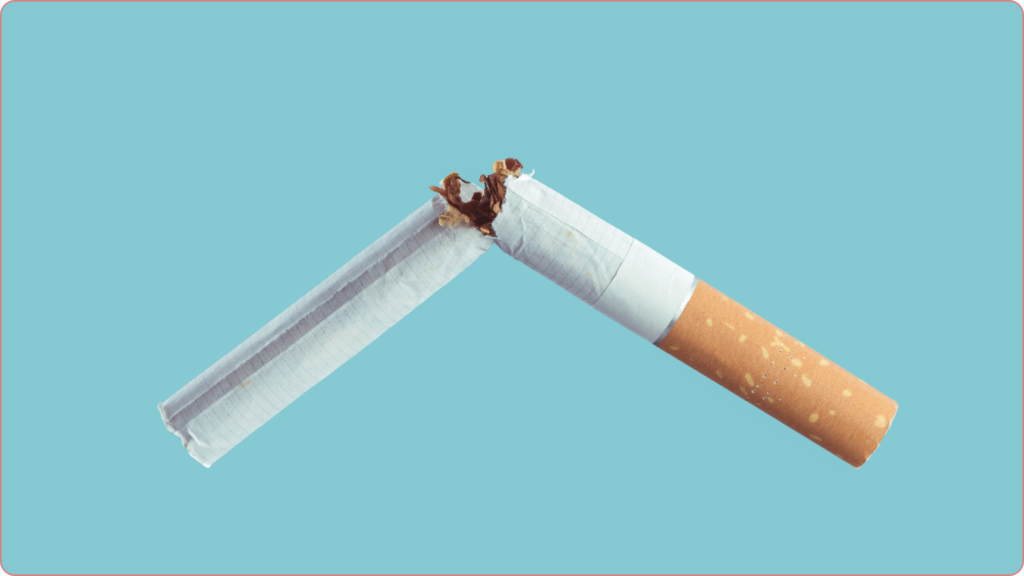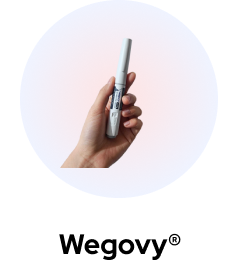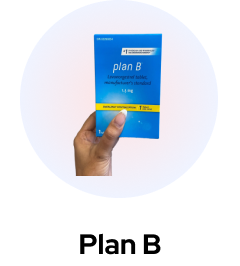Quitting smoking and vaping can be a daunting task. And if you’re one of the 70% of Canadians that want to quit, you’ve probably tried a few times already.
Luckily, there are a few medications that can help reduce your cravings and set you on a path of long term quitting. From Champix, Zyban, and Nicotine Replacement Therapy, this guide will help you find the perfect product for you. Of course, you’ll need to speak to a medical professional to double check these options are a good fit and then get the required prescription. We can help.
How do these medications stop smoking cravings?
These medications primarily focus on receptors within your brain, either blocking or changing how your brain registers cravings. This will reduce the ‘pleasurable’ effects of smoking and vaping, making it feel like a chore or gross. And if something is gross or annoying to do, the chances are much lower that you’ll do it!

When should you stop smoking or vaping after starting a medication?
It’ll depend on the medication you end up using: for example, don’t stop or decrease your smoking until at least one week on Champix to ensure there is enough time for the medication to build up in your body and start working. Your medical team will tell you exactly when you should stop smoking or vaping while on the meds.
Nicotine withdrawal – it’s real and can be nasty Upon starting medication, you may experience nicotine withdrawal symptoms that can be confused with side effects from the medications above. Over time, these withdrawal symptoms should subside. Common nicotine withdrawal symptoms include difficulty sleeping, mood changes (irritability, frustration, anger), depressed mood, restlessness, and increased appetite.1
Should you stop taking the medication if you experience side effects?
If you experience side effects at the beginning, realize that it will take some time for your body to adjust. If you power through the first little bit, your body should eventually get used to the medication, and your side effects may subside. Nicotine withdrawal symptoms can also be confused with medication side effects at the beginning of your quit journey. Remember that side effects are possible and are likely to subside over time.
Smoking cessation medications are typically used for a minimum of three months. Your health care provider may give you an additional three-month supply based on your quit journey and original habits.

Here's some of the most commonly prescribed medications to stop smoking and vaping:
Champix (Varenicline) – Prescription
Champix is thought to work on the nicotine (the addictive ingredient) receptors in the brain which are associated with smoking addiction.1 This drug tightly binds the nicotine receptor, blocks nicotine from binding, and mimics the action of nicotine. Essentially, the nicotine can’t sneakily influence your brain anymore! In one 2016 study, more participants quit successfully on Champix (varenicline) than Zyban (bupropion) or nicotine replacement therapy.2
How Champix Works
Champix works by blocking and mimicking nicotine in the brain, reducing cravings and withdrawal symptoms without the high from smoking. It offers a flexible quitting approach, allowing individuals to gradually decrease smoking in their own time. This method eases the quitting process, tailored to personal needs.
Key points include its dual-action on nicotine receptors, the ability to personalize the quitting journey, and manageable side effects that tend to lessen over time. Consulting healthcare professionals is crucial to ensure compatibility and address any side effects. Champix provides a science-backed, flexible path to quitting smoking.
If you are looking for flexibility, Champix may be a great fit for you! With this drug, you can slowly titrate down from your initial total daily tobacco use until you are no longer smoking. You don’t have to cold turkey quit right away – you have the choice to decide when to stop smoking.
There are three different strategies for how Champix can be used.1 :

Side Effects of Champix
Common side effects include nausea, vomiting, sleep disturbances, headache, and abnormal dreams.1 If you experience side effects after a Champix dose increase, fear not! The evidence we have suggests that quit rates are similar between low and high doses.1 Definitely talk to your healthcare team so they can work with you to find the right dose to reduce the side effects.
Zyban (Bupropion) – Prescription
Zyban is thought to help reduce cravings by increasing levels of dopamine (a pleasure hormones) and noradrenaline (a fight-or-flight hormone) in the brain.3 Although the drug is not known to have a direct effect on nicotine, it has been shown to help patients quit smoking. In one 2020 study, Zyban was shown to be as effective as nicotine replacement therapy (NRT)4
How Zyban Works
Zyban aids in smoking cessation by boosting dopamine and noradrenaline levels in the brain, reducing cravings and easing withdrawal symptoms. Users are advised to aim for quitting by the second week of treatment, offering a structured timeline for cessation.
As an antidepressant, Zyban can also alleviate mood-related symptoms during quitting, though caution is advised for those already on antidepressants. Side effects like sleep disturbances, dry mouth, and nausea may occur but typically lessen over time. Consulting healthcare professionals is crucial for managing these effects and ensuring the treatment aligns with individual health needs.
How is Zyban Different From Champix
Unlike Champix, you don’t have as much flexibility when setting a quit date with Zyban. It’s recommended that you quit by the end of week two after starting this medication. Despite the lack of flexibility, there are some other benefits to Zyban. Since Zyban is an antidepressant by class, it can help with any mood related symptoms you may have. However it may not be recommended if you are currently on a stable regime of antidepressants – wouldn’t want to mess with what is working for you.
Common side effects include sleep disturbances, dry mouth, and nausea.3 Again, chat with your medical team to see what they can do to help reduce these issues.
If you aren’t interested in prescription medications, there is Nicotine Replacement Therapy (NRT) There are many nicotine products on the market that can help you quit smoking without having to take prescription medications.5 Oftentimes people will combine NRT with prescription drugs to help change how their brain handles cravings, as well as their mouth and hands.
Let's talk about vapes, baby
For years, nicotine was considered to be comparatively harmless but addictive. However, recent studies show this may not be the case. While nicotine through a vape is the lesser evil (compared to tobacco based cigarettes, cigars or dip/chewing tobacco), it isn’t safe like originally thought.
Below is a list of potential negative effects from long term e-cigarette/vape use:
1. Impaired wound healing and blood vessel formation6
2. Increased blood pressure and heart rate7,8
3. Breathing problems (ie. asthma, increased coughing)9–13
4. Bladder cancer14
5. Chronic musculoskeletal pain15
Vapes are helpful for smoking cessation, not as a stand in for other tobacco products. It’s important for consumers to be educated about the potential danger of using e-cigarettes – especially, for those who are using them recreationally and not for smoking cessation. Remember, while nicotine is better than cigarettes, cigars or dip, our ultimate goal should be to not be dependent on any smoking products.
Quitting tobacco is hard – be kind to yourself quitting smoking is a journey. Remember that success can take time and looks different for everyone. Having regular appointments with a healthcare provider who provides counselling can help keep you on track.
Diet and Exercise To Stopping Vaping
A successful journey to quit vaping isn’t just about breaking a habit; it involves transforming your lifestyle to support your goal. Diet and exercise are foundational elements that can significantly aid in this transformation.
A nutritious diet and regular physical activity not only improve your overall health but also equip you with the strength to combat cravings and withdrawal symptoms. Here, we highlight how integrating healthy eating habits and exercise into your daily routine can be a game-changer in your quest to stop vaping.
Diet and Exercise: Integral Allies in Your Quit Journey
When it comes to stopping vaping, diet and exercise play pivotal roles that often go underestimated. Together, they form a powerful duo that supports your body and mind through the challenging process of nicotine withdrawal.
Nutritional Support: A Balanced Diet for Healing
A well-balanced diet rich in fruits, vegetables, whole grains, and lean proteins can significantly impact your ability to quit vaping. Nutrients found in these foods bolster your immune system, improve mood, and reduce stress levels, all of which are vital during the cessation period. Foods high in antioxidants help combat oxidative stress caused by vaping, while magnesium-rich foods can reduce irritability and anxiety.
Hydration: Water as a Craving Buster
Increasing water intake is another simple yet effective strategy. Often, cravings can be mistaken for dehydration. By staying hydrated, you not only keep cravings at bay but also help flush out toxins from your body faster.
Exercise: A Natural Mood Booster
Exercise is another crucial component. Physical activity releases endorphins, known as ‘feel-good’ hormones, which can elevate your mood and reduce the stress and anxiety associated with quitting vaping. Regular exercise also improves sleep quality, boosts energy levels, and can help manage weight gain, a common concern for those stopping nicotine use.
How to Deal with Triggers and Managing Cravings
Overcoming the urge to vape, especially when faced with triggers, is a critical challenge on the path to cessation. Effective management of these triggers and cravings is essential for lasting success. By identifying your triggers and employing strategies to navigate through cravings, you can maintain control over your quitting journey.
Here, we outline practical steps and techniques to help you manage these moments, fostering resilience and perseverance in your commitment to quit vaping.
Identifying Triggers: The First Step to Control
Understanding and identifying your triggers is essential in managing cravings. Common triggers include stress, alcohol consumption, social settings, or even specific times of the day. Once identified, you can develop strategies to avoid or cope with these triggers without reverting to vaping.
Mindfulness and Relaxation Techniques: Tools for Craving Management
Mindfulness, meditation, and deep-breathing exercises can significantly reduce the intensity of cravings. By focusing on the present and practicing deep, controlled breaths, you can navigate through a craving without giving in.
Substitution: Healthy Alternatives to Vaping
Finding healthy substitutes for vaping can also be beneficial. This could mean chewing gum, snacking on fruits or nuts, using stress balls, or engaging in a hobby when the urge to vape strikes. These alternatives can provide a distraction and fulfill the oral fixation that often accompanies vaping.
Support Systems: Leverage Community and Professional Help
Building a strong support system is vital. This can include friends, family, support groups, or professional help from counselors or quitlines. Sharing your experiences and challenges with others who understand can provide encouragement and accountability, making the journey less isolating.
Reward Yourself: Celebrate Milestones
Finally, reward yourself for milestones reached without vaping. Whether it’s a day, a week, or a month, acknowledging these achievements can boost your morale and motivate you to continue on your quit journey.
Combining these strategies with a commitment to a healthier lifestyle can significantly increase your chances of successfully stopping vaping, leading to a healthier, nicotine-free life.
Frequently Asked Questions
Will my lungs heal if I quit vaping?
Yes, your lungs have a remarkable ability to heal from the damage caused by vaping, but the extent of healing can vary depending on how long and how much you’ve vaped. After quitting, your lungs begin to repair the irritation and damage caused by the chemicals in e-cigarettes. Improvement in lung function and respiratory symptoms can be noticed within a few weeks to months. However, it’s important to note that while many of the physical effects can be reversed, some damage, especially from long-term vaping, may not completely heal.
Is it easier to quit vaping than smoking?
The difficulty in quitting vaping compared to smoking varies from person to person and depends on several factors, including the level of nicotine dependence, the individual’s environment, and personal reasons for vaping. Some people find vaping harder to quit due to the higher nicotine content in some e-liquids and the ability to vape in more places than one can smoke. Others may find it easier because vaping is less entrenched in history and social norms than smoking. Ultimately, quitting any form of nicotine addiction requires a personal commitment and often professional support.
Will I gain weight if I stop vaping?
Some people might experience weight gain after quitting vaping, as nicotine can suppress appetite and increase metabolism. Quitting may lead to increased appetite and decreased metabolic rate, leading to weight gain for some. However, this can be managed with a healthy diet and regular exercise. It’s also worth noting that the health benefits of quitting vaping far outweigh the potential of gaining a few extra pounds.
What is the biggest danger of vaping?
The biggest danger of vaping lies in its association with nicotine addiction and the potential harm to lung health. Nicotine is highly addictive and can harm brain development in teenagers. Additionally, vaping can expose the lungs to harmful chemicals and fine particles that can lead to respiratory problems, lung disease, and, in severe cases, death. The long-term effects of vaping are still being studied, but evidence suggests it is far from risk-free and poses significant health risks.
Ready to quit? We're ready to help
References:
- Champix Product Monograph [Internet]. Pfizer Canada Inc. Kirkland, QC; 2019 [cited 2022 Aug 12]. Available from: https://www.pfizer.ca/sites/default/files/201902/Champix_PM_221214_22Jan2019_EN.pdf
- Cahill K, Lindson-Hawley N, Thomas KH, Fanshawe TR, Lancaster T. Nicotine receptor partial agonists for smoking cessation. Cochrane Database Syst Rev [Internet]. 2016 May 9 [cited 2022 Aug 12];2016(5). Available from: https://www.cochranelibrary.com/cdsr/doi/10.1002/14651858.CD006103.pub7/full
- Zyban Product Monograph [Internet]. Valeant Canada LP. Laval, QC; 2016 [cited 2022 Aug 12]. Available from: https://pdf.hres.ca/dpd_pm/00036009.PDF
- Howes S, Hartmann-Boyce J, Livingstone-Banks J, Hong B, Lindson N. Antidepressants for smoking cessation. Cochrane Database Syst Rev [Internet]. 2020 Apr 22 [cited 2022 Aug 12];2020(4). Available from: https://www.cochranelibrary.com/cdsr/doi/10.1002/14651858.CD000031.pub5/full
- Petrasko K, Reeve C. Smoking Cessation [Internet]. In: Compendium of Therapeutic Choices for Minor Ailments; 2018 [cited 2022 Aug 12]. Available from: https://myrxtx-ca/search
- Liu Z, Zhang Y, Youn JY, Zhang Y, Makino A, Yuan JXJ, et al. Flavored and Nicotine-Containing E-Cigarettes Induce Impaired Angiogenesis and Diabetic Wound Healing via Increased Endothelial Oxidative Stress and Reduced NO Bioavailability. Antioxidants (Basel, Switzerland) [Internet]. 2022 May 1 [cited 2022 Aug 12];11(5). Available from: https://pubmed.ncbi.nlm.nih.gov/35624768/
- Larue F, Tasbih T, Ribeiro PAB, Lavoie KL, Dolan E, Bacon SL. Immediate physiological effects of acute electronic cigarette use in humans: A systematic review and meta-analysis. Respir Med [Internet]. 2021 Dec 1 [cited 2022 Aug 12];190. Available from: https://pubmed.ncbi.nlm.nih.gov/34808583/
- Gonzalez JE, Cooke WH. Acute effects of electronic cigarettes on arterial pressure and peripheral sympathetic activity in young nonsmokers. Am J Physiol Heart Circ Physiol [Internet]. 2021 Jan 1 [cited 2022 Aug 12];320(1):H248–55. Available from: https://pubmed.ncbi.nlm.nih.gov/33164580/
- Li X, Zhang Y, Zhang R, Chen F, Shao L, Zhang L. Association Between E-Cigarettes and Asthma in Adolescents: A Systematic Review and Meta-Analysis. Am J Prev Med [Internet]. 2022 Jun 1 [cited 2022 Aug 12];62(6):953–60. Available from: https://pubmed.ncbi.nlm.nih.gov/35337694/
- Chand BR, Hosseinzadeh H. Association between e-cigarette use and asthma: a systematic review and meta-analysis. J Asthma [Internet]. 2022 [cited 2022 Aug 12];59(9). Available from: https://pubmed.ncbi.nlm.nih.gov/34433366/
- Chaffee BW, Barrington-Trimis J, Liu F, Wu R, McConnell R, Krishnan-Sarin S, et al. E-cigarette use and adverse respiratory symptoms among adolescents and Young adults in the United States. Prev Med (Baltim) [Internet]. 2021 Dec 1 [cited 2022 Aug 12];153. Available from: https://pubmed.ncbi.nlm.nih.gov/34418439/
- Sreedharan S, Mian M, Robertson RA, Rhodes A. Radiological findings of e-cigarette or vaping product use associated lung injury: A systematic review. Heart Lung [Internet]. 2021 Sep 1 [cited 2022 Aug 12];50(5):736–41. Available from: https://pubmed.ncbi.nlm.nih.gov/34130236/
- Bourke M, Sharif N, Narayan O. Association between electronic cigarette use in children and adolescents and coughing a systematic review. Pediatr Pulmonol [Internet]. 2021 Oct 1 [cited 2022 Aug 12];56(10):3402–9. Available from: https://pubmed.ncbi.nlm.nih.gov/34407315/
- Bjurlin MA, Matulewicz RS, Roberts TR, Dearing BA, Schatz D, Sherman S, et al. Carcinogen Biomarkers in the Urine of Electronic Cigarette Users and Implications for the Development of Bladder Cancer: A Systematic Review. Eur Urol Oncol [Internet]. 2021 Oct 1 [cited 2022 Aug 12];4(5):766–83. Available from: https://pubmed.ncbi.nlm.nih.gov/32192941/
- Dai Y, Huang J, Hu Q, Huang L, Wu J, Hu J. Association of Cigarette Smoking with Risk of Chronic Musculoskeletal Pain: A Meta-Analysis. Pain Physician [Internet]. 2021 [cited 2022 Aug 12];24(8):495–506. Available from: https://pubmed.ncbi.nlm.nih.gov/34793634/












 (US)
(US)